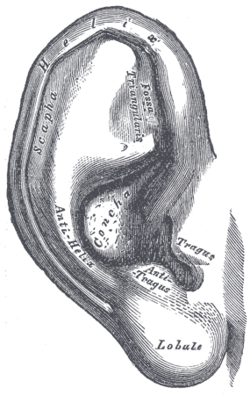- Outer ear
-
Outer ear 
External and middle ear, opened from the front. Right side. 
The auricula. Lateral surface. Latin auris externa Gray's subject #229 1033 MeSH External+Ear Dorlands/Elsevier Outer ear The outer ear is the external portion of the ear, which consists of the pinna, concha, and external auditory meatus. It gathers sound energy and focuses it on the eardrum (tympanic membrane). One consequence of the configuration of the external ear is to selectively boost the sound pressure 30- to 100-fold for frequencies around 3 kHz. This amplification makes humans most sensitive to frequencies in this range - and also explains why they are particularly prone to acoustical injury and hearing loss near this frequency. Most human speech sounds are also distributed in the bandwidth around 3 kHz.[1]
Pinna, or auricle
The visible part is called the pinna. It is composed of a thin plate of yellow elastic cartilage, covered with integument, and connected to the surrounding parts by ligaments and muscles; and to the commencement of the external acoustic meatus by fibrous tissue. Many mammals can move the pinna (with the auriculares muscles) in order to focus their hearing in a certain direction in much the same way that they can turn their eyes. Most humans, unlike most other mammals, do not have this ability.
Ear canal, or external auditory meatus
From the pinna the sound pressure waves move into the ear canal, a simple tube running through the middle ear. This tube leads inward from the bottom of the auricula and conducts the vibrations to the tympanic cavity and amplifies frequencies in the range 3 kHz to 12 kHz.
References
- ^ Chapter 13, pg 317 of Neuroscience, 4th Edition. Dale Purves

This anatomy article is a stub. You can help Wikipedia by expanding it.
